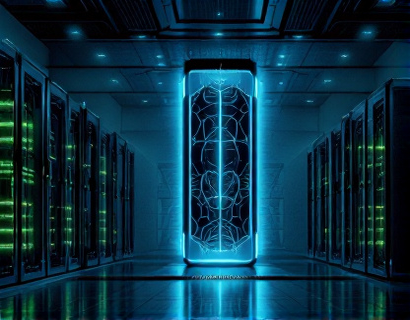Blockchain-Enabled Registry Software: Revolutionizing Data Management
In the rapidly evolving landscape of data management, the integration of blockchain technology has emerged as a transformative force, offering unprecedented levels of security, transparency, and efficiency. This article delves into the realm of blockchain-enabled registry software, exploring how it is revolutionizing the way professionals and enthusiasts approach data management, security, and digital transformation. By leveraging the inherent properties of blockchain, such as immutability and decentralization, this innovative software is redefining the standards for registry management.
Understanding Blockchain Technology
Before diving into the specifics of blockchain-enabled registry software, it is essential to grasp the fundamental concepts of blockchain technology. At its core, a blockchain is a distributed ledger that records transactions across multiple computers in such a way that the registered transactions cannot be altered retroactively. This technology ensures that once data is recorded, it becomes nearly impossible to modify or delete, providing a high level of data integrity and security.
Blockchain operates on a network of nodes, each maintaining a copy of the entire ledger. Transactions are grouped into blocks, and each block is linked to the previous one through cryptographic hashes, forming a chain. This linkage ensures that any attempt to alter a block would require changing all subsequent blocks, a task that is computationally infeasible. The decentralized nature of blockchain eliminates the need for a central authority, reducing the risk of single points of failure and enhancing resilience against cyber threats.
Enhanced Security in Registry Management
One of the most significant advantages of blockchain-enabled registry software is its ability to provide enhanced security for data management. Traditional registry systems are often vulnerable to breaches, data tampering, and unauthorized access. In contrast, blockchain's cryptographic techniques and decentralized architecture offer robust protection against these threats.
Each transaction in a blockchain is encrypted and verified through consensus mechanisms, such as Proof of Work or Proof of Stake. This ensures that only valid transactions are added to the ledger, and any attempt at fraud is immediately detected and rejected. The immutable nature of blockchain means that once data is recorded, it cannot be altered without leaving a trace, making it an ideal solution for maintaining the integrity of registry data.
Moreover, blockchain-enabled registry software often incorporates advanced security features such as multi-signature transactions, smart contracts, and zero-knowledge proofs. Multi-signature transactions require multiple authorized parties to approve a transaction, adding an extra layer of security. Smart contracts automate and enforce contractual obligations, reducing the risk of human error and fraud. Zero-knowledge proofs allow for verification of data without revealing the actual data, preserving privacy while ensuring authenticity.
Transparency and Trust Building
Transparency is a cornerstone of blockchain technology, and it plays a crucial role in building trust in registry management. In a blockchain-based system, all transactions are recorded on a public ledger that is accessible to all participants. This transparency ensures that every change, addition, or deletion of data is visible and verifiable, fostering a high level of trust among users.
For professionals in data management, security, and digital transformation, this level of transparency is invaluable. It allows for real-time monitoring of registry processes, enabling quick identification and resolution of issues. Stakeholders can have confidence that the data they rely on is accurate and has not been tampered with, which is particularly important in industries such as finance, healthcare, and government, where data integrity is paramount.
Furthermore, the transparency provided by blockchain can help organizations comply with regulatory requirements. Regulatory bodies can audit the blockchain ledger to verify compliance, reducing the need for extensive manual audits and paperwork. This not only saves time and resources but also ensures a higher standard of compliance.
Efficiency and Process Streamlining
Blockchain-enabled registry software not only enhances security and transparency but also significantly improves efficiency in data management processes. Traditional registry systems often involve multiple intermediaries, manual data entry, and cumbersome approval workflows, leading to delays and increased operational costs.
By automating many of these processes through smart contracts, blockchain-enabled registry software can streamline operations and reduce the need for intermediaries. Smart contracts execute predefined actions when certain conditions are met, ensuring that processes are completed accurately and promptly. This automation reduces the risk of human error and speeds up transaction times, leading to more efficient and cost-effective registry management.
Additionally, the decentralized nature of blockchain eliminates the need for centralized servers and databases, reducing the overhead costs associated with maintaining these infrastructures. Organizations can benefit from lower operational expenses while enjoying a more resilient and scalable system.
Use Cases in Various Industries
The applications of blockchain-enabled registry software extend across various industries, each benefiting from the unique advantages it offers. In the financial sector, blockchain can enhance the security and efficiency of transactions, reduce fraud, and improve compliance with regulatory standards. For example, blockchain-based systems can streamline the process of issuing and managing securities, bonds, and other financial instruments, reducing the time and cost associated with these activities.
In the healthcare industry, blockchain can secure patient records, ensuring that sensitive information is protected and easily accessible to authorized personnel. This not only enhances patient privacy but also improves the accuracy and consistency of medical data, leading to better patient outcomes. Blockchain can also facilitate the tracking of pharmaceuticals, reducing the risk of counterfeit drugs entering the supply chain.
In government and public sector, blockchain-enabled registry software can transform land registry, voting systems, and identity verification processes. Land registries can become more transparent and efficient, reducing disputes and fraud. Voting systems based on blockchain can ensure the integrity and transparency of elections, increasing voter trust. Identity verification using blockchain can provide secure and portable digital identities, simplifying access to services and reducing identity theft.
For IT and software development teams, blockchain-enabled registry software can streamline version control, collaboration, and asset management. Developers can track changes to codebases, manage licenses, and ensure compliance with open-source licenses, all while maintaining a secure and transparent record of activities.
Challenges and Considerations
While the benefits of blockchain-enabled registry software are clear, there are several challenges and considerations that organizations should be aware of when adopting this technology. One of the primary challenges is the scalability of blockchain networks. While blockchain offers many advantages, its performance can be limited by the number of transactions it can process per second. However, advancements in blockchain technology, such as sharding and layer 2 solutions, are addressing these scalability issues.
Another consideration is the regulatory landscape. As blockchain technology is still relatively new, regulations vary by region and are often evolving. Organizations must stay informed about local and international regulations to ensure compliance. Additionally, the integration of blockchain with existing systems can be complex and may require significant investment in infrastructure and training.
Despite these challenges, the potential benefits of blockchain-enabled registry software make it a compelling choice for organizations looking to enhance their data management practices. By embracing this technology, professionals and enthusiasts can unlock new levels of security, transparency, and efficiency, driving innovation and trust in their respective fields.
Conclusion
Blockchain-enabled registry software represents a significant leap forward in data management, offering unparalleled security, transparency, and efficiency. By leveraging the inherent properties of blockchain, organizations can streamline their processes, build trust, and stay ahead in a rapidly digitalizing world. Whether in finance, healthcare, government, or other industries, the adoption of blockchain-enabled registry software is not just a trend but a necessity for those committed to excellence in data management.










































